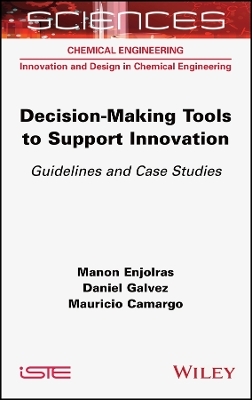
Decision-making Tools to Support Innovation
Iste Ltd (Verlag)
978-1-78945-089-7 (ISBN)
Through studying practical cases from various fields (e.g. energy, marketing and sustainable development), this book addresses all the stages of the innovation process, highlighting some of the main decisions that can be faced by organizations.
Based on the historical research conducted at the ERPI Laboratory (University of Lorraine) in Nancy, France, this book presents six innovation practices: strategy, creativity, design, project management, human resources and capitalization of knowledge. These practices are then illustrated through examples of decision support methods' applications.
Manon Enjolras is a lecturer at the University of Lorraine, France (ERPI Laboratory/ENSGSI). Her research concerns the metrology of innovation and the application of multicriteria and data analysis methodologies. Daniel Galvez is a professor at the Department of Industrial Engineering of the University of Santiago, Chile and coordinator of the LEIND Laboratory. His areas of research are innovation management and decision support. Mauricio Camargo is a professor at ENSGSI and the director of the ERPI Laboratory (University of Lorraine) in France. His work focuses on the management of innovation projects, technology management and the design of complex product, process and industrial systems.
Foreword ix
Christian FONTEIX
Introduction xiii
Chapter 1 The Selection of Ideas During a Creativity Workshop: An Application of PROMETHEE 1
1.1 Context and challenges in decision-making 2
1.1.1 The phases of a creative workshop 2
1.1.2 Evaluation and selection of ideas 4
1.2 The PROMETHEE method 9
1.2.1 Methodological concept: the preference function 10
1.2.2 Application process 14
1.3 Application of PROMETHEE to the selection of ideas 16
1.3.1 Context of the workshop 16
1.3.2 Discussion of the results 22
1.4 To go further 23
1.4.1 The Gaia plane 23
1.4.2 Regarding the different versions of PROMETHEE 25
1.5 The PROMETHEE method: instructions for use 26
1.5.1 PROMETHEE step by step 26
1.5.2 Application of PROMETHEE with software support 32
1.6 References 39
Chapter 2 The Upstream Phases of Product Design: An Application of AHP 43
2.1 Context and challenges in decision-making 44
2.1.1 The challenges of the upstream phases of the design process 44
2.1.2 A trend in innovation: sustainable design 45
2.1.3 Definition of the decision model 46
2.2 The AHP method: analytic hierarchy process 49
2.2.1 The fundamental principle: the relative importance of criteria 49
2.2.2 Application of the method 54
2.3 Going further: the question of interdependence between criteria 62
2.3.1 The Dematel method 63
2.3.2 Application to the case study 67
2.3.3 Proposal for an AHP/Dematel combined approach 68
2.4 AHP: instructions for use 72
2.4.1 Practical guide 72
2.4.2 Illustration of related free software 78
2.5 References 83
Chapter 3 Marketing Strategy During the Market Entry Phase: An Application of Rough Sets 85
3.1 Context and challenges in decision-making 86
3.1.1 Decision-making in marketing 86
3.1.2 Definition of the decision model 88
3.2 The Rough Sets method or the theory of approximate sets 90
3.2.1 Terminology 90
3.2.2 Fundamental principle: indiscernibility 91
3.2.3 Application of the method 93
3.3 Discussion of the results obtained 96
3.3.1 Conditional rules obtained 96
3.3.2 Operational exploitation of rules 98
3.3.3 To go further: dominance-based rough sets approach 100
3.4 The Rough Sets method: instructions for use 103
3.4.1 The case of extracting information from a database: an example using the freeware program 4Emka 103
3.4.2 The case of implicit preference modeling 108
3.4.3 Step-by-step application 109
3.5 References 120
Chapter 4 Building a Coherent Project Portfolio: An Application of MAUT 123
4.1 Context and challenges in decision-making 124
4.1.1 The selection of innovative projects 124
4.1.2 Decision-making in the petroleum industry 124
4.1.3 Definition of the decision model 126
4.2 The MAUT method 127
4.2.1 Terminology and methodological concepts 127
4.2.2 Application of the method 130
4.3 To go further 138
4.3.1 Consideration of the constraints in making the decision 138
4.3.2 Synergies between criteria/between projects 139
4.3.3 The accuracy of the utility function 141
4.4 The MAUT method: instructions for use 141
4.4.1 MAUT step by step 141
4.4.2 Using software supports 149
4.5 References 154
Chapter 5 The Recruitment Process in Human Resources: An Application of ELECTRE 157
5.1 Context and challenges in decision-making 158
5.1.1 Human resources management and innovation 158
5.1.2 The challenges of the recruitment process 159
5.2 The ELECTRE method 161
5.2.1 Methodological concepts 161
5.2.2 Application of ELECTRE to the hiring of new staff members 164
5.3 To go further 173
5.3.1 Addressing incomparability in the results 173
5.3.2 Improving the accuracy of input data: processing qualitative criteria 177
5.4 ELECTRE: instructions for use 178
5.4.1 Practical guide 179
5.4.2 Illustration of related free software 187
5.5 References 190
Chapter 6 Knowledge Management in the Supply Chain: An Application of TOPSIS 193
6.1 Context and challenges in decision-making 194
6.1.1 Knowledge management in the supply chain 194
6.1.2 Definition of the decision model 196
6.2 The TOPSIS method 199
6.2.1 Methodological concepts 200
6.2.2 Application of the method 204
6.3 To go further 213
6.3.1 The imprecise nature of human judgment: moving towards "fuzzy logic" 213
6.3.2 Sensitivity analysis or the proposal of simulation scenarios 216
6.4 The TOPSIS method: instructions for use 218
6.4.1 TOPSIS step by step 218
6.4.2 Illustration of related free software 225
6.5 References 229
Conclusion 231
List of Authors 237
Index 239
| Erscheinungsdatum | 12.08.2023 |
|---|---|
| Reihe/Serie | ISTE Consignment |
| Verlagsort | London |
| Sprache | englisch |
| Gewicht | 662 g |
| Themenwelt | Naturwissenschaften ► Chemie |
| ISBN-10 | 1-78945-089-6 / 1789450896 |
| ISBN-13 | 978-1-78945-089-7 / 9781789450897 |
| Zustand | Neuware |
| Informationen gemäß Produktsicherheitsverordnung (GPSR) | |
| Haben Sie eine Frage zum Produkt? |
aus dem Bereich



